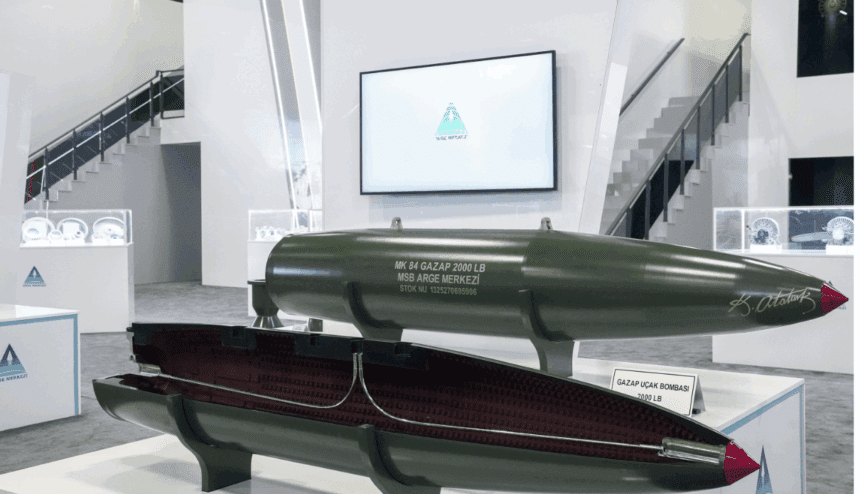Turkey unveiled two advanced air-launched munitions—GAZAP (WRATH), a thermobaric bomb, and NEB-2 Ghost, a deep-penetration bunker-buster—at the International Defense Industry Fair (IDEF) 2025 in Istanbul. Both weapons were developed by the Turkish Ministry of National Defense’s research and development center and are now certified for operational use.
GAZAP: High-Density Fragmentation and Thermobaric Capability
Weighing 970 kilograms (2,000 pounds), GAZAP is designed for maximum area effect through a thermobaric explosion mechanism and a high-density fragmentation system. Upon detonation, it disperses 10,000 pre-formed metal fragments, achieving a density of 10.16 fragments per square meter—over three times greater than conventional bombs in its class.
The thermobaric system uses a fuel-air mixture that ignites in two stages, producing temperatures reaching 3,000°C and generating intense overpressure. According to officials, GAZAP can be deployed from F-16 and F-4 Phantom aircraft, and discussions are underway to integrate it with unmanned aerial vehicles (UAVs).
Live test footage showed the bomb creating a flash and visible shockwaves, followed by a debris cloud across a 160-meter radius.
NEB-2 Ghost: Deep Penetration and Delayed Detonation
Also weighing 970 kilograms, the NEB-2 Ghost is a bunker-buster bomb developed to target fortified underground structures. According to defense officials, it can penetrate 7 meters of C50-grade reinforced concrete, significantly more than the 2.4 meters typically achieved by similar munitions designed for C35-grade concrete, such as those used in nuclear facilities.
In test trials, the bomb penetrated 90 meters underground before detonation. The delayed explosion—timed at 240 milliseconds instead of the standard 25—was designed to maximize structural disruption.
Like GAZAP, the NEB-2 is compatible with Turkey’s F-16 aircraft and is intended for use against hardened targets such as bunkers and underground facilities.
Broader Context
The presentation of these systems at IDEF 2025 reflects Turkey’s ongoing investment in domestic defense manufacturing and its aim to diversify its range of conventional weapons. The country has been expanding its capabilities across several categories, including drones, naval platforms, guided munitions, and missiles.
Observers note that Turkey’s defense industry has focused on increasing indigenous production and reducing dependence on foreign suppliers amid shifting geopolitical dynamics. These new weapons are expected to be integrated into national defense planning and may also be considered for future defense export opportunities.
IDEF 2025 also featured other new systems, including the Tayfun Block-4 hypersonic missile, part of a broader strategy to enhance strike range and technological self-sufficiency.
While the international response to the new bomb systems remains limited at this stage, analysts are expected to assess the implications of these capabilities in regional security and defense procurement contexts.



